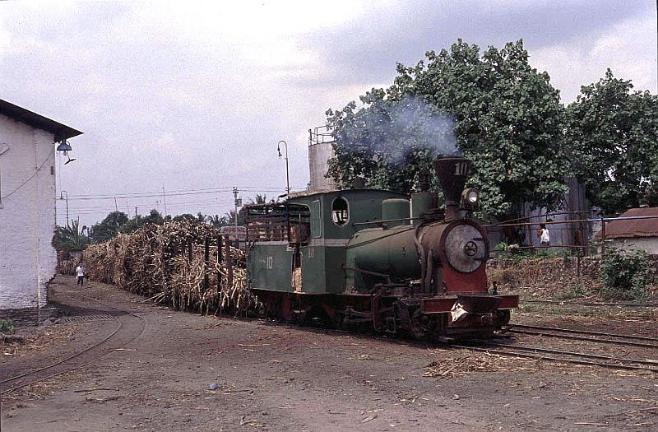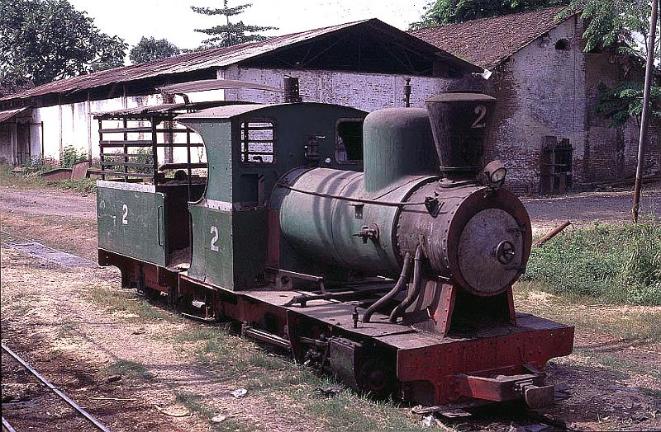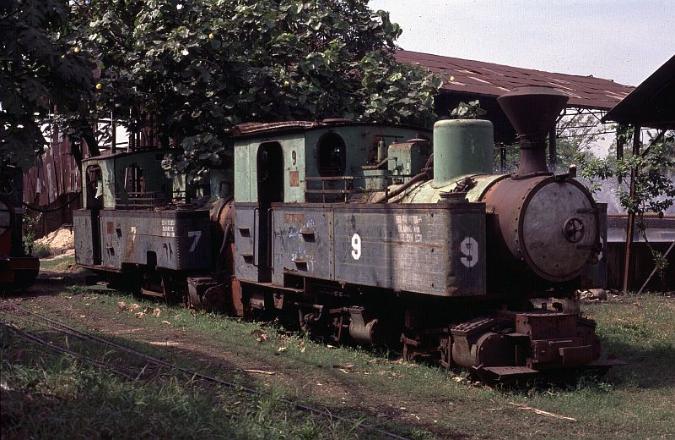| Jatibarang is one of two 600mm mills which are located to the south of Tegal, the other being Pangka. I visited this mill in 2004 and again in 2006. On the first occasion the mill was operating at full tilt and a number of cane trains were worked from the road delivery yard to the mill. Most, if not all, of the cut sugar cane is brought to the mills by lorry and then loaded onto railway wagons for the final journey into the crushing plant. It is really difficult to determine why this is necessary since the road delivery yard is a matter of mere yards away from the mill. Logic would suggest that it would be far simpler and cheaper to offloading directly into the mill but presumably this prevents the lorries having to wait many hours to offload and allows the mills to process the cut cane both day and night. At Jatibarang the loaded wagons are hauled into the mill from the road delivery yard by locomotives operating boiler first and therefore presenting far more in the way of photographic opportunities than Tersana Baru. Jatibarang locomotive shed still possesses a turntable in front of a half-roundhouse although it seems to be used mainly for posing locomotives for the visiting enthusiast - and only then at a steep but negotiable price! On my second visit in 2006 the mill was out of use for maintenance purposes and this meant that some time was spent looking at some of the locos that were not in use or were awaiting disposal. |
| Very much in use during my day at Jatibarang was Jung 0-8-0T No.5 (built 1916) Despite its small size and lack of bagasse wagon it was capable of hauling long trains of loaded wagons into the mill. (9 August 2004) |
| Also standing out of use was this Jung 0-4-4-0T No.9, built in 1930 and said to be the last Mallet locomotive to be built in Germany. It was supplied to HE Oving of Rotterdam for use at Jatibarang At the time of my 2004 visit it was receiving no attention so I merely recorded its presence and expected to eventually learn of its demise. However this was not to be its fate. It was bought by Graham Lee, a UK enthusiast, and moved to the Statfold Barn Railway near Tamworth in Staffordshire. It has subsequently been beautifully restored and has seen service on the Welsh Highland Railway where it became the first full-size Mallet used for passenger services in the UK. It is seen on the left on 28th April 2011 at the Britannia Bridge crossing in Porthmadog (Photographer: Bruce Brayne) |
| The third working locomotive on the day of my visit was No.10, a Jung 0-8-0 built in 1911, seen here bringing a train from the road delivery yard into the mill itself. (9 August 2004) |
| Couillet 0-6-0T No.2 (built 1910) was in steam during both of my visits. This delightful little engine would not seem out of place in a 'Thomas The Tank Engine' film! (9 August 2004) |


| JATIBARANG TEGAL REGION |
| Orenstein & Koppel 0-8-0T No.12 (built 1931) brings a long train of loaded cane wagons on the short journey from the road delivery yard to the mill buildings. The locomotive detaches from its train and propels the previous line of wagons into the mill before returning to the yard to collect its next load. (9 August 2004) |

The half roundhouse at Jatibarang
is one of the most impressive
railway buildings anywhere on the
island. It is accessed by means of a
turntable although this does not
appear to be used to turn engines
which all appear to work smoke
box first towards the
shed.
(August 2006)
is one of the most impressive
railway buildings anywhere on the
island. It is accessed by means of a
turntable although this does not
appear to be used to turn engines
which all appear to work smoke
box first towards the
shed.
(August 2006)

Whilst not in use on the day of my
visit, this delightful little Couillet
0-6-0T No.1 (built 1910) seemed to
be in perfect working order as it
stood just outside the roundhouse
(August 2006)
This loco has subsequently been
moved to Tasik Madu mill near Solo
for regauging and use on tourist
trains
visit, this delightful little Couillet
0-6-0T No.1 (built 1910) seemed to
be in perfect working order as it
stood just outside the roundhouse
(August 2006)
This loco has subsequently been
moved to Tasik Madu mill near Solo
for regauging and use on tourist
trains

Far less serviceable was this Jung
0-8-0T No.7 (built 1924) which
was stored inside the roundhouse
together with several other engines
0-8-0T No.7 (built 1924) which
was stored inside the roundhouse
together with several other engines





Another shot of Jung 0-8-0 No.10
(built in 1911) bringing a train
from the road delivery yard into
the mill. In the background can be
seen a number of motorbikes
waiting at the level crossing. At
times considerable patience is
needed as the trains make their
leisurely pace to their destination.
(built in 1911) bringing a train
from the road delivery yard into
the mill. In the background can be
seen a number of motorbikes
waiting at the level crossing. At
times considerable patience is
needed as the trains make their
leisurely pace to their destination.

Most of the engines at Jatibarang
were designated as tank locos and
were fitted with auxiliary tenders
to carry the bagasse or wood used
to fire the engine. However No.10
was a genuine tender engine as
can be seen from this rear view.
were designated as tank locos and
were fitted with auxiliary tenders
to carry the bagasse or wood used
to fire the engine. However No.10
was a genuine tender engine as
can be seen from this rear view.

In addition to the locomotives
which were in service or stored out
of use, there were a number of
other engines in a variety of
derelict states including this
unidentified tank locomotive that
almost certainly will never turn a
wheel again.
which were in service or stored out
of use, there were a number of
other engines in a variety of
derelict states including this
unidentified tank locomotive that
almost certainly will never turn a
wheel again.


Regular steam activity at Jatibarang has now ceased and the mill yard is worked by two Japanese diesels from Cepiring.
Like a number of mills in Java it is probable that steam could be provided 'on demand' for visitors with Jung 0-8-0T No.5 being
available for a visiting group to charter.
Like a number of mills in Java it is probable that steam could be provided 'on demand' for visitors with Jung 0-8-0T No.5 being
available for a visiting group to charter.